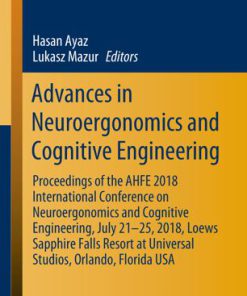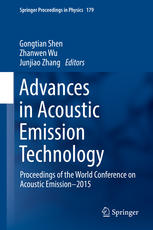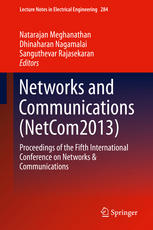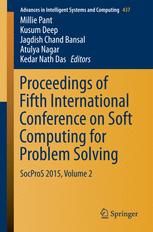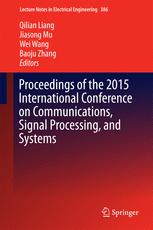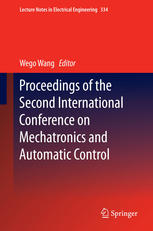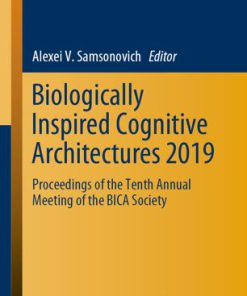Advances in Cognitive Neurodynamics V Proceedings of the Fifth International Conference on Cognitive Neurodynamics 2015 1st Edition by Rubin Wang 9811002076 9789811002076
$50.00 Original price was: $50.00.$25.00Current price is: $25.00.
Advances in Cognitive Neurodynamics V Proceedings of the Fifth International Conference on Cognitive Neurodynamics 2015 1st Edition by Rubin Wang – Ebook PDF Instant Download/DeliveryISBN: 9811002076, 9789811002076
Full download Advances in Cognitive Neurodynamics V Proceedings of the Fifth International Conference on Cognitive Neurodynamics 2015 1st Edition after payment.
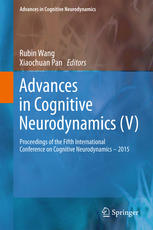
Product details:
ISBN-10 : 9811002076
ISBN-13 : 9789811002076
Author: Rubin Wang
This proceedings contains articles submitted to the fifth International Conference on Cognitive Neurodynamics (ICCN2015). In ICCN2015, twelve invited plenary lectures were presented by the leading scientists in their respective research fields. More than 15 mini-symposiums are organized by specialists with topics covering: motor control and learning, dynamic coding in distributed neural circuits, dynamics of firing patterns and synchronization in neuronal systems, information and signal processing techniques in neurotechnology, neural oscillations and synaptic plasticity in the hippocampus, new perspective on model-based vs. model-free brain process, neural mechanisms of internal switching, neuroinformation computation, neural model and dynamics, imaging human cognitive networks, neuroinformatics, neuroergonomics & neuroengineering, dynamic brain for communication, visual information processing and functional imaging and neural mechanisms of language processing. All articles are peer-reviewed. The ICCN is a series conference held every two years since 2007.
Advances in Cognitive Neurodynamics V Proceedings of the Fifth International Conference on Cognitive Neurodynamics 2015 1st table of contents:
Part IPlenary Talk
1 Putting Sensory Back into Voluntary Motor Control
Abstract
1.1 Introduction
1.2 Control Theories to Interpret Voluntary Control
1.3 Rapid Motor Corrections During Voluntary Control
1.4 Neural Basis of Rapid Motor Corrections
References
2 Is Visual Processing in Primates Strictly Hierarchical?
Abstract
2.1 Introduction
2.2 Methods
2.3 Results
Acknowledgements
References
3 Self-organization of a Second Kind: General Scope and a Cortical Case Study
Abstract
3.1 Introduction
3.2 Computational Results
3.3 Discussion
Acknowledgments
References
4 Toward Autonomous Intelligence: From Active 3D Vision to Invariant Object and Scene Learning, Reco
Abstract
4.1 Invariant Object Category Learning, Recognition, and Search
4.2 ARTSCAN
4.3 Positional ARTSCAN
4.4 Distributed ARTSCAN
4.5 ARTSCAN Search
4.6 ARTSCENE and ARTSCENE Search
4.7 3D ARTSCAN
4.8 3D ARTSCAN Search and Autonomous Adaptive Mobile Robots
References
5 The Cognitive Control of Goal-Directed Action: How Predictive Learning Affects Choice
Abstract
5.1 Introduction
5.2 Cognition and Action
5.3 A Behavioral Model of the Cognitive Control of Action
5.4 Neural Bases of Predictive Learning and Choice
5.5 The Role of Cholinergic Interneurons in the Accumbens Shell
5.6 Beyond the Accumbens
Acknowledgments
References
6 Functional Connectivity Mapping of Decision-Making in Drosophila Melanogaster
Abstract
Acknowledgments
References
7 Neurodynamics of Decision-Making—A Computational Approach
Abstract
7.1 Introduction
7.2 Model Description
7.3 Simulation Example and Results
7.4 Discussion
Acknowledgments
References
8 Brain Pattern Analysis Based on Magnetic Resonance Imaging
Abstract
Acknowledgments
References
9 Dopamine Prediction Errors and the Relativity of Value
Abstract
References
10 The Neural Mechanism of Direction- and Orientation-Selective Neurons for Processing Direction, Sp
Abstract
10.1 Introduction
10.2 Method/Models
10.3 Results
10.4 Conclusions
Acknowledgments
References
Part IINeural Dynamics in Motorand Sensory Systems
11 Stability and Flexibility During Human Motor Control
Abstract
11.1 Introduction
11.2 Stability and Flexibility During Bipedal Stance and Gait
11.3 A Model of Intermittent Control During Bipedal Stance and Gait
11.4 Discussion
References
12 Context-Dependent Human Motor Memories: Function, Implementation, and Manipulation
Abstract
12.1 Introduction
12.2 Motor Memories Formed Depending on Behavioral Contexts
12.3 Possible Mechanisms Creating Distinct Motor Memories
12.4 Manipulation of Motor Memories
References
13 A Model of Gait Cycle Variability During Human Walking
Abstract
13.1 Introduction
13.2 Model Preparation
13.3 Analysis Method
13.4 Simulation Results
13.5 Discussion
13.6 Summary
References
14 Coordinate Systems in the Motor System: Computational Modeling and EEG Experiment
Abstract
14.1 Introduction
14.2 Neural Representations of Reaching in Motor Cortex
14.2.1 Controversy Over How Motor Neurons Represent Body Movements
14.2.2 Cross Products as Neural Activities in Motor Cortex
14.3 Modeling of Motor Adaptation in Humans Using Cross Products
14.3.1 Reference Frames in Dynamic and Kinematic Motor Adaptations
14.3.2 Modeling Motor Adaptation Using Cross-Product Bases
14.4 Directional Tuning and Coordinate Systems in Noninvasive EEG Experiment
14.4.1 Simultaneous Recording of Body Movements and High-Density EEG
14.4.2 Correlation Analysis for Directional Tuning
14.5 Conclusion
References
15 Simulation Study on Neuromuscular Model-Inspired Control Strategy for Variable Stiffness Actuator
Abstract
15.1 Introduction
15.2 Similarity Analysis Between Biological and Robotic Joint Systems
15.3 Bio-inspired Joint Stiffness Control Strategy and Simulation
15.4 Conclusion and Discussion
Acknowledgments
References
16 Changes in the Inner Gene Expression of Lateral Olivocochlear Receptors After the Loss of the Des
Abstract
16.1 Introduction
16.2 Methods
16.2.1 Surgical Procedures
16.2.2 RNA Extraction
16.2.3 Quantitative Real-Time PCR
16.2.4 Statistical Analysis
16.2.5 Localisation of the Lesions
16.3 Results
16.3.1 Localisation of the Lesions
16.3.2 qPCR Results
16.4 Discussion
Acknowledgments
References
17 Effect of Parvalbumin Deficiency on Distributed Activity and Interactions in Neural Circuits Acti
Abstract
17.1 Introduction
17.2 Materials and Methods
17.2.1 Experimental Subjects
17.2.2 Surgical Procedure
17.2.3 Behavioral Procedure
17.2.4 Electrophysiological Recording
17.2.5 Histology
17.3 Results
17.3.1 Operant Behavior
17.3.2 Electrophysiological Results
17.4 Discussion
Acknowledgments
References
18 Dynamic Patterns of Cortical Activation During Different Types of Learning Tasks and Unpredictabl
Abstract
18.1 Introduction
18.2 Methods
18.3 Results
18.4 Discussion
References
19 The Application of Spatiotemporal Energy Model in the Simulation of Population Responses in Early
Abstract
19.1 Introduction
19.2 Methods
19.3 Results
19.4 Conclusions
Acknowledgments
References
20 Aspect Ratio of the Receptive Field Makes a Major Contribution to the Bandwidth of Orientation Se
Abstract
20.1 Introduction
20.2 Materials and Methods
20.2.1 Animal Preparation
20.2.2 Single-Unit Recordings
20.2.3 Procedures
20.2.4 Circular Variance and Tuning Width
20.3 Results
20.3.1 WHH and CV in the V1 Population
20.3.2 Comparison of WHH and CV with Aspect Ratio
20.4 Discussion
Acknowledgments
References
21 Nonlinear Dynamical Analysis of Spontaneous EEG Recordings in Rats After Chronic Spinal Cord Inju
Abstract
21.1 Introduction
21.2 Materials and Methods
21.2.1 Animals
21.2.2 EEG Recordings
21.2.3 Sample Entropy
21.2.4 Behavior Analysis
21.3 Results
21.4 Discussion and Conclusions
Acknowledgments
References
Part IIIInteractive Dynamicsin Cognitive Functions
22 Causality in Neuroscience and Its Limitations: Bottom-up, Top-down, and Round-About
Abstract
22.1 Introduction
22.2 Functional Levels: Bottom-up and Top-down
22.3 Feedback Loops with Nonlinearities and Time Delays
22.4 Autonomic and Mental Functions
22.5 Causality and Emergence: Complications and Limitations
Acknowledgments
References
23 Decisions and Downward Causation in Neural Systems
Abstract
23.1 Introduction
23.2 Methods
23.3 Results
23.4 Discussion
Acknowledgments
References
24 Top-down and/or Bottom-up Causality: The Notion of Relatedness in the Human Brain
Abstract
24.1 Introduction: Cause and Effect—A Complex Topic, but a Simple Relation (0/1)?
24.1.1 Problem of Communication Between the Different Neurosciences?
24.2 The Concept of Causation in the Human Brain/Mind
24.2.1 Evolutionary Argument, Claim: The Concept of Causation Enables Our “I” to Cause Action in (
24.2.2 Cause and Effect: A Distinct Type of Link at All Functional Stages of Neural Information Proc
24.2.3 From Biological to Psychological Representations of Causality: From the Brain to the Mind
24.3 Conclusion: Causality/Reason in Human Consciousness
References
25 Overviewing Causality or Over-Interpreting Noise: Is Modern Neuroscience Shaping Our View of the
Abstract
25.1 Introduction
25.1.1 Positive Symptoms of Psychosis: Paradigmatic Example for an Over-Interpretation of Noise?
25.2 From Neuroimaging to Psychophysiology—A Meta-comparison
25.2.1 Noise in MRI—Imaging and Psychophysiology Data Analysis
25.2.2 Disadvantages of MRI and the Positive Bias in Neuroimaging Literature
25.2.3 Advantages and Disadvantages of Imaging in the Context of Clinical Psychology
25.2.4 Future Aim: Combination of Research Theory and Methods
References
26 Theoretical Models of Decision-Making in the Ultimatum Game: Fairness vs. Reason
Abstract
26.1 Introduction
26.2 Theoretical and Experimental Methods
26.3 Results
26.4 Discussion
Acknowledgments
References
27 Dynamic Interactions in Prefrontal Functional Connectivity During Adolescence
Abstract
27.1 Introduction
27.2 Methods
27.3 Results
27.3.1 Overall Spike Count Correlation
27.3.2 Correlation Dynamics Across Epochs
27.3.3 Dependence on Response Properties
27.4 Discussion
Acknowledgments
References
28 Causal Interaction Between Prefrontal Cortex and Striatum Estimated by Granger Causality
Abstract
28.1 Introduction
28.2 Materials and Methods
28.2.1 Behavioral Task
28.2.2 Data Recording
28.2.3 Data Analysis
28.3 Results
28.4 Discussion
Acknowledgments
References
29 Two Strategies for Interactive Planning
Abstract
29.1 Introduction
29.2 Evidence for Memory-Based Behavioral Planning
29.3 Extension to Interactive Planning
29.4 Discussion
Acknowledgments
References
30 TMS-EEG for Probing Distinct Modes of Neural Dynamics in the Human Brain
Abstract
30.1 TMS-EEG Concurrent Recordings
30.2 TMS-EEG and Local and Global Neural Dynamics
30.3 A Mechanistic Account for TMS-Induced Phase Resetting
30.4 Probing Distinct Modes of Synchrony Dynamics
Acknowledgments
References
31 Estimating Information Transmission Time Between Prefrontal Cortex and Striatum by Transfer Entro
Abstract
31.1 Introduction
31.2 Methods
31.2.1 Wiener’s Principle of Causality
31.2.2 Introduction of Transfer Entropy
31.2.3 Transfer Entropy with a Prediction Time
31.2.4 Statistical Tests
31.2.5 Transfer Entropy to Estimate Information Transfer Delay Time
31.3 Results
31.3.1 Simulation Results
31.3.2 Delay Time Estimated from Local Field Potentials
31.4 Discussion
Acknowledgments
References
32 Reward-Modulated Functional Connectivity Between Prefrontal Cortex and Striatum
Abstract
32.1 Introduction
32.2 Materials and Methods
32.2.1 The Behavioral Task
32.2.2 Data Acquisition
32.2.3 Data Analysis
32.3 Results
32.3.1 Power Spectra of LFP
32.3.2 Phase Synchronization
32.4 Discussion
Acknowledgments
References
33 On the Role of Intrinsic Rewards in Communication
Abstract
33.1 Introduction
33.2 The Concept of `Intrinsic Reward’
33.3 Communication as a Function of Reward Type
Acknowledgments
References
Part IVNeural Dynamics in Hippocampus
34 Hydrogen Sulfide Prevents Synaptic Plasticity from Vascular Dementia-Induced Damage via Inhibitin
Abstract
34.1 Introduction
34.2 Methods
34.2.1 Animal Care
34.2.2 Induction of VD
34.2.3 Morris Water Maze (MWM) Experiment
34.2.4 Long-Term Depression Recording (LTD)
34.2.5 Western Blot Assay
34.2.6 Statistical Analysis
34.3 Results
34.3.1 NaHS Ameliorated the Impaired Spatial Learning and Memory Abilities
34.3.2 NaHS Ameliorated the Impaired Long-Term Depression in Hippocampus
34.3.3 NaHS Inhibited the Activation of Autophagy in Hippocampus
34.4 Discussion
Acknowledgments
References
35 The Impact of Nasal Copper Nanoparticle Exposure on Rats’ Synaptic Plasticity and Spatial Cogniti
Abstract
35.1 Introduction
35.2 Materials and Methods
35.2.1 Copper Nanoparticles and Solutions
35.2.2 Animals
35.2.3 Experimental Design
35.2.4 Morris Water Maze
35.2.5 Electrophysiology Recording (Long-Term Potentiation Recording)
35.2.6 ROS and GSH-Px Assay in Hippocampus
35.2.7 Histology Analysis
35.2.8 Statistical Analysis
35.3 Results
35.3.1 Characterization of Nanoparticles
35.3.2 Copper Content in Hippocampus
35.3.3 Morris Water Maze
35.3.4 In Vivo Long-Term Potentiation (LTP)
35.3.5 ROS and GSH-Px Assay in Hippocampus Homogenate
35.3.6 HE Staining Analysis
35.4 Discussion and Conclusion
Acknowledgments
References
36 Theta Phase Time-Delayed Modulating Low Gamma Amplitude in Hippocampal CA3–CA1 Network
Abstract
36.1 Introduction
36.2 Method/Models
36.2.1 Animals and Treatments
36.2.2 Electrophysiological Experiments
36.2.3 Cross Frequency Mutual Information
36.2.4 Cross Frequency-Evolution Map Approach
36.2.5 Surrogate Data
36.2.6 Data Pretreatment and Statistical Analysis
36.3 Results
36.3.1 Time-Lag-Depended PAC
36.3.2 Phase-Amplitude Coupling from CA3 to CA1 by CF-CMI and CF-EMA
36.4 Discussion
Acknowledgments
References
37 Roles of DA and 5-HT in Modulating Neural Oscillatory Synchronization
Abstract
37.1 Introduction
37.2 Method/Models
37.2.1 Animals and Treatments
37.2.2 Experimental Design
37.2.3 Surgical Procedure
37.2.4 Phase-Amplitude Coupling–Phase Locking Value (PAC–PLV)
37.2.5 Statistical Analysis
37.3 Results
37.3.1 LTP Induction Was Affected by SCH-23390 and 8-OH-DPAT
37.3.2 Theta-Fast Gamma Coupling Was Attenuated by 8-OH-DPAT
37.4 Discussion
Acknowledgments
References
38 Dynamic Information Routing in the Hippocampus
Abstract
38.1 Introduction
38.2 Materials and Methods
38.2.1 Subjects, Behavioral Task, and Data Recording
38.2.2 Behavioral Data
38.2.3 Statistical Evaluation
38.3 Results
38.3.1 Within-Session Dynamics of Behavioral Measures
38.3.2 Spiking Activity and Gamma Oscillations
38.4 Discussion
Acknowledgments
References
39 Rule Switching Affects Cross-Frequency Couplings in Rat Hippocampus
Abstract
39.1 Introduction
39.2 Methods
39.2.1 Behavioral Task
39.2.2 Data Acquisition and Analysis
39.3 Results
39.4 Discussion
Acknowledgments
References
Part VImaging Cognitive Networks
40 Functional Connectivity Analysis of Cognitive Reappraisal Using Sparse Spectral Clustering Method
Abstract
40.1 Introduction
40.2 Materials and Methods
40.2.1 Subjects
40.2.2 Experimental Paradigm and Data Set
40.2.3 Data Processing
40.2.4 Sparse Spectral Clustering
40.2.5 Voxel-Based Aggregation Index (VBAI)
40.3 Results
40.4 Conclusion
Acknowledgments
References
41 Theta Coupling in the Human EEG During the Control of Bottom-up and Top-down Attention
Abstract
41.1 Introduction
41.2 Methods
41.2.1 Subject
41.2.2 Stimuli and Task
41.2.3 Data Processing
41.3 Results
41.3.1 Behavioral Results
41.3.2 Theta Coupling Results
41.4 Discussion
41.5 Conclusion
References
42 Phase-Dependent Alteration of Functional Connectivity Density During Face Recognition in the Infr
Abstract
42.1 Introduction
42.2 Methods
42.2.1 Subjects and Procedure
42.2.2 Data Acquisition and Preprocessing
42.2.3 Data Analysis
42.3 Results
42.4 Discussion
Acknowledgment
References
43 The Supramodal Brain Network for the Recognition of Faces and Bodies: Is Visual Experience Necess
Abstract
43.1 Introduction
43.2 Haptic Recognition of Faces and Body Parts in Sighted Individuals
43.3 The Effect of Early Visual Deprivation on the Brain Network Underlying the Haptic Recognition o
Acknowledgments
References
44 Over-Complete Analysis for Resting-State fMRI Data
Abstract
44.1 Introduction
44.2 Materials and Methods
44.2.1 Over-Complete Analysis Method
44.2.2 Subjects
44.2.3 Imaging Parameters
44.2.4 Data Analysis
44.3 Results and Discussion
44.4 Conclusions
Acknowledgments
References
45 Decoding Brain States with Simulated Microgravity from Baseline Using Functional Connectivity of
Abstract
45.1 Introduction
45.2 Methods
45.2.1 Participants
45.2.2 Design
45.2.3 Image Acquisition and Preprocessing
45.2.4 Default Functional Connectivity Measure
45.2.5 Classification
45.3 Results
45.4 Discussion
Acknowledgments
References
46 Experimental Studies on the Contralateral Regulation of Cerebral Blood Flow Using a Patient-Speci
Abstract
46.1 Introduction
46.2 Materials and Methods
46.3 Results and Discussion
46.4 Conclusions
References
47 A Robust Coherence-Based Brain Connectivity Method with an Application to EEG Recordings
Abstract
47.1 Introduction
47.2 Methods
47.3 Application to Real EEG Recordings
47.3.1 Subjects and Recordings
47.3.2 Results
47.4 Discussion
Acknowledgments
References
Part VIAdvanced Brain Computer Interaction
48 Robust Averaging of Covariance Matrices by Riemannian Geometry for Motor-Imagery Brain–Computer
Abstract
48.1 Introduction
48.2 Spatial Covariance Matrices in MI-BCI
48.3 Geometric Classification of MI-BCI Data
48.3.1 The Manifold of Symmetric Positive-Definite Matrices
48.3.2 Tangent Space Linear Discriminant Analysis—Review
48.4 Robust Averaging of Covariance Matrices
48.4.1 Riemannian Geometric Median
48.4.2 Geometric Trimmed Averages
48.5 Experimental Evaluation
48.6 Conclusion
References
49 Vibrotactile Brain–Computer Interface with Error-Detecting Codes
Abstract
49.1 Introduction
49.2 Methods
49.2.1 Experiments with and Without Error-Detecting Codes Comparison
49.2.2 EEG Experiments
49.2.3 Feature Extraction and Classification
49.3 Results
49.4 Discussion and Conclusion
Acknowledgments
References
People also search for Advances in Cognitive Neurodynamics V Proceedings of the Fifth International Conference on Cognitive Neurodynamics 2015 1st:
advances in cognitive science
advances in cognitive systems
advances in cognitive psychology journal
advances in cognitive systems 2022
advances in neurodevelopmental disorders
Tags: Advances, Cognitive Neurodynamics, the Fifth, International Conference, Cognitive Neurodynamics, Rubin Wang
You may also like…
Science (General) - International Conferences and Symposiums
Engineering Technique - Automation




